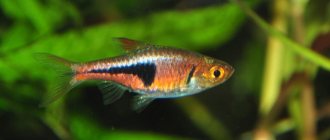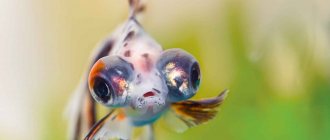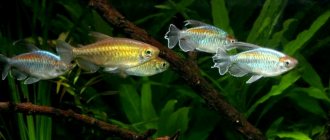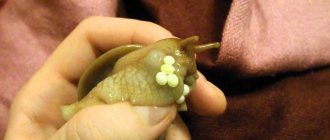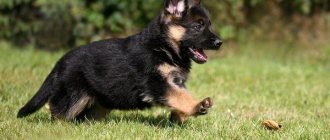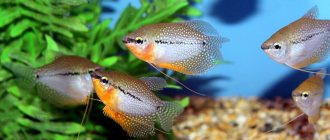Share this article:
Large representatives of the freshwater aquarium with an interesting history, unusual appearance and habits... They may not be as famous as other fish, but they are no less interesting. In this article we will talk about representatives of a unique family of fish, which are called animated dinosaurs, dragons, polypteruses.
A little history
It is generally accepted that these creatures appeared in ancient Africa during the Cretaceous period, which is more than 60 million years ago. As evidence of such a distant origin, the primitive anatomy of polypterus is given: a cartilaginous skeleton, which is similar in design to a shark or stingray, the location of the cranial plates and some others.
The polypteridae family (lat. Polypteridae) has two genera:
- Kalamoichthys (lat. Erpetoichthys) with the only representative of the Kalamoichthys calabar (snake fish),
- Polypterus (lat. Polypterus) with numerous species and subspecies.
What does polypterus look like?
These amazing creatures have a serpentine appearance:
- wide head with large nostrils
- highly elongated body no more than 90 cm long.
The body is protected by large diamond-shaped scales. In its composition, scientists discovered a ganoid - a solid protein that was present in the scales of extinct fish.
Another feature is the characteristic unusual dorsal fin, which starts from the middle of the back and ends at the tail, and it is not solid, but somewhat dissected (there is one such fin for every 15-20 vertebrae). All parts of it can rise and fall at the request of the fish.
The pectoral fins have two diverging bones separated by cartilage. With their help, fish can cross the river bed and rest, using them as supports.
Polypterus has a modified swim bladder, consisting of two sections and resembling a lung. Thanks to this organ, the fish is able to capture air at the surface of the water. This is an invaluable property when living in oxygen-poor water bodies and when migrating from one to another.
Feeding a predator
In natural conditions, polyfins eat invertebrates: insects, larvae, worms, mollusks, and small fish. In an aquarium you can get by with dry food for predators. Polypterus eat it at the bottom, swallowing the food whole. It is convenient to feed your dragon with sinking tablets - they are the right size and immediately sink to the bottom. If tablets are not available, large sinking granules will do. If your Polypterus is tame and takes food from your hands, treat it with cichlid floating sticks. Choose your feeding regimen individually.
Please note: polypterus will not eat on the surface and in high light conditions.
Underwater dragons also eat any protein food:
- shrimp,
- tubifex,
- mussels,
- chopped beef heart and veal,
- bloodworm,
- small live sea or river fish.
In older (seven years and older) individuals, their teeth wear down; they will also be happy with plant foods:
- chopped lettuce, spinach, dandelion leaves;
- pieces of zucchini;
- finely chopped cucumbers;
- porridge and potatoes (in the form of puree).
Polypterus are big gluttons, control the size of their portions, otherwise overeating and obesity cannot be avoided.
Varieties of Polypterus
Senegalese (lat. Polypterus senegalus). He is the most active, curious and persistent among others. Body size does not exceed 30-40 cm. Friendly towards its relatives and other large fish.
Congolese (Ornatipinis) (lat. Polypterus ornatipinnis) . Very beautiful, bright and patterned. The main background of the body is gray-brown with a white marble pattern, the abdomen is white and yellow, and on the head there is a pattern in the form of a mesh. It is also called the marble dragon. It grows up to 40 cm. You can see it only during feeding. This is a very agile predator, much more aggressive than the Senegalese.
Endlicher (lat. Polypterus enlicherii) . A large, powerful fish, up to 75 cm in size. Not very active during the day, moves rather slowly. Requires keeping in a separate large aquarium and live food.
Delhezi (lat. Polypterus delhezi) . The color is bright, the size is small (maximum 35 cm), so it is very popular among lovers of this type of fish. Spends the day in hiding.
Calabar calamoicht (lat. Erpetoichthys calabaricus) . Feeds on small fish. It has an elegant long thin body, and if there are the slightest cracks, it will definitely fit through them.
Weeksii (lat. Polypterus weeksii) . This is perhaps the largest species. Its body dimensions reach 90 cm.
Let's briefly go over the most popular of them.
Congolese polypterus.
Interesting Facts
- The African polyfin is a frequent inhabitant of demonstration aquariums. Its relic appearance makes it very attractive and mysterious.
- Where Polypterus senegalese lives, video is often filmed. After all, the active and businesslike behavior of the dragon fish is a very entertaining sight.
- The predator quickly becomes attached to its owner and swims out of its hiding place to meet him.
- If the integument of the body is kept moist, the dragon can live without water for a very long time.
- At the beginning of the 20th century, photos of Senegalese polypterus were sold for a lot of money.
Polypterus senegalese
Polypterus senegalus, gray polypterus, Senegalese dragon - all these are the names of this fish. It is often confused with Macrognathus, but it is a completely different species. It was found in Africa and India, in Senegal in the Nile River basin, in Niger and Gambia. He loves shallow water without currents, thickets of plants and shelters in the clayey shore.
This is a predator. In nature it reaches a size of 70 cm, in an aquarium - no more than 40 cm. The body color is uniform, silver-gray with a hint of blue. Albinos are marble-white in color.
The body is elongated and covered with diamond-shaped scales. The pectoral fins are in the form of fleshy appendages; the dorsal fin has a hard spine, to which 5-18 soft rays are attached, similar to combs or a saw. The caudal fin is oval in shape. The ventral ones are strongly shifted towards the anal ones, almost towards the tail.
A unique feature of the Senegalese is that it is double-breathing, that is, it is able to stay and move on land for some time thanks to its swim bladder and pectoral fins.
Has poor eyesight, but a good sense of smell. The nostrils are clearly defined. Sharp teeth and large, cold eyes complete his portrait.
Albino Senegalese polypterus.
What should an aquarium be like?
The Senegalese dragon is unpretentious, but it requires systematic care. An aquarium will need at least 200 liters. There must be a lid on top (tightly fitting, but with holes) and it is better to seal all excess cracks, since the polypterus can crawl out, fall out and die on the floor from drying out.
The fish spends most of its time in the lower layers of water in search of food, periodically rising to the surface to breathe.
Access to air must be required, otherwise the dragon will die!
It is better to maintain water parameters in the following ranges:
- 24-28 degrees Celsius,
- acidity 6.2-7.8 рР,
- hardness 5-20°dH,
- filtration,
- weekly changes.
It is allowed to decorate the pond with grottoes, stones, and driftwood. Plants can be planted, or you can do without them. With proper care, a Senegalese can live up to 10 years.
The lighting in the aquarium should be dim; in bright light, polypterus experience stress.
Feeding the Senegalese dragon
From food he prefers live food:
- shrimp;
- squid;
- earthworms;
- small fish.
Dry granulated food and flakes can also be consumed. Adults need to be fed 1-2 times a week.
When young, dragons swim in schools, but as they mature, they prefer solitude and personal territory.
You should not house them with small fish, as they will definitely eat the latter.
Proportional fish that Polypterus cannot swallow, such as large American cichlids, are suitable as neighbors.
Long nostrils help Polypterus to hunt.
Reproduction
In captivity, it is extremely difficult to achieve reproduction from polypteruses. In nature, spawning occurs during the rainy season and certain changes in water quality can trigger mating behavior. Some aquarists have noticed that massive changes of soft, slightly acidic water can encourage fish to spawn.
Their gender differences are subtle.
- Males have a spade-shaped anal fin.
- Females have slightly wider heads.
The fish choose a mate and swim together for several days, touching their bodies and biting their fins. The female then spawns eggs. For this process, it is better to lay Java moss in advance.
The eggs must be removed to prevent the parents from eating them. The fry are aggressive and need to be sorted by size. The offspring require strong aeration and frequent changes of small amounts of water.
A week after the babies appear, they begin to be fed Artemia nauplii. And when they grow to 5 cm, they are cared for like adults.
The lung in Polypterus does not form immediately, so in the first months of life the fry have external gills on their heads, just like axolotls.
These unusual fish are able to recognize a person, are not picky about their living conditions, are very hardy and rarely get sick.
Gills on the head of a juvenile specimen.
Diseases and treatments
The Senegalese predator has strong health and rarely gets sick. His immunity can weaken only due to violation of the conditions of detention. For example, polypterus can get sick due to poor nutrition. Since he eats protein foods, he cannot be overfed (the fish can become obese). Symptoms of this disease are apathy and lethargy. The dragon may simply lie there and not react to what is happening around it. The abdomen of an obese polyfin is rounded. Due to obesity, metabolism is disrupted, and some internal organs (for example, kidneys) may fail. If the fish is left untreated, it may die. A sick polypterus needs to be put on a diet - fed once every 3-4 days. Low-fat bloodworms are suitable as food.
If a multi-feather breathes heavily and often rises for air, it means that it has parasites. These are monogenean fluke parasites. A weakened fish may refuse to eat, become “lazy” and move little. You need to take a closer look at the dragon's head (worms may be visible). A number of means can be used to remove parasites:
- malachite green;
- formalin;
- chlorophos;
- methylene blue;
- azipyrine.
You don’t have to remove the fish, but instead put the medicine in the usual water. If you slightly increase the water temperature (by 1–2 °C), the worm will leave the dragon’s body and enter the water that has already been treated with the medicine.
If Polypterus has darkened gills, it may have been poisoned. This often happens due to the filter not working correctly or being dirty. The dragon, poisoned by ammonia, tries to get out of the water and does not eat well. His fins may turn red. A secondary symptom is ruffled scales. First you need to make sure that it is poisoning. A test for high ammonia levels can be purchased at any pet pharmacy. A contaminated aquarium must be thoroughly cleaned, all dirt must be removed from the bottom, the filter must be removed and the sponge rinsed with running water. In addition, you need to replace part of the water (at least a third of the total volume).
During general cleaning, it is better to transplant the fish into a separate tank with pre-prepared water. Some aquarists also include vitamins in the treatment process.
Change the water of day 4 every day by 20 percent - this will remove ammonia and the medicine. When the redness disappears, we will solve the second problem, we need to boost his immunity: you can drip fishtamin (these are vitamins), the scales may go down on their own, but they may not.
Polypterus delgesi
The most popular of all types of polypterus, as it has a bright color combined with small size (no more than 35 cm). It is olive-gray above with dark stripes across the body, and yellowish below.
All sides are strewn with dark spots. Males are brighter than females. His nostrils are tubular and his eyes are small. The caudal fin is pointed.
Aquarium parameters
For this type of polypterus, a 300 liter aquarium will be sufficient. The height is not important, but you don’t need to take it too high. As with the previous type, special attention should be paid to the cover and holes from the equipment hoses.
It is recommended to make the water level 7-8 cm below the top edge of the container.
The pond may be without decoration, but then it looks less impressive. Driftwood, stones, caves are suitable as decoration. If plants are planned, then it is better to take mosses and specimens with hard leaves.
The conditions of detention are similar to the Senegalese polypterus. Particular attention should be paid to good filtration. Let us also add that lighting does not play a big role. Twilight will be enough. You can additionally install a pair of blue spectrum lamps to turn on at night when the main light is turned off.
What to feed delgezi?
Delgezi search for food by smell, moving slowly and picking it up from the bottom. Therefore, the soil should be selected so that it is easy to care for (a thin layer of sand is recommended).
It is better to select feed with sufficient protein content:
- mussels;
- shrimps;
- fry;
- small fish.
It is allowed to give flakes, tablets and granules, but always sinking ones.
Despite poor eyesight, these polypteruses have an instant reaction when necessary. Hunting is carried out mainly at night.
Reproduction in captivity
It is quite difficult to obtain offspring in a home aquarium. For successful spawning, it is recommended to increase the water temperature, make it soft and slightly acidic.
The female lays her eggs in a cup, which the male constructs from the caudal and anal fins, and then he scatters them on plants with small leaves. Parents are dismissed.
After 3-4 days the fry appear. After a week they begin to feed them microworms and Artemia nauplii.
Polypterus delgesi.
Breeding
Most of these animals appear in pet stores as a result of being caught in the wild. It is possible to breed them, but it is not the easiest task.
Stimulation of spawning is carried out through a decrease in temperature. But only Polypterus does not produce offspring constantly. The mating season begins in July and lasts about 3 months. The couple spins beautifully in a mating dance. The male and female rub and even bite slightly. The female lays small eggs, so it is better to add various mosses to the aquarium during the spawning period, which will become a refuge for future offspring. As soon as the eggs have been laid, they are removed from the aquarium along with the moss, since the parents do not take care of the eggs.
The larvae appear on the fourth day. The first food is Artemia nauplii. The young have external gills, which disappear over time. The fry acquire the hunting instinct early. Therefore, they can attack weaker individuals. Accordingly, in order to prevent many deaths, it is necessary to separate the young animals by size.
Polypterus endlichera
The homeland of this species is Cameroon, Nigeria, Mali, Sudan, South Africa, etc. Its representatives live both in rivers and in wetlands.
The size of the endlicher is quite impressive: in nature up to 75 cm, in an aquarium up to 50 cm. In captivity, it lives for about 10 years, but cases of longevity are also known.
The body of these polypterus is long, brown, with dark spots. The pectoral fins are large, the dorsal fin resembles a jagged ridge and smoothly merges into the caudal fin.
An aquarium for juveniles starts from 100 liters, for adults - from 800 liters. The conditions of detention are similar to the previous ones:
- maintain the temperature at 22-27°C,
- pH: 6.0-8.0,
- hardness: 5-25°H,
- soil - sand.
From plants you can plant echinodorus or nymphea, which have wide leaves and will create shade. It is better to plant them in pots or cover them at the roots with driftwood. Partial shade and the presence of shelters will prevent stress in the fish.
These fish are predators, so in addition to pellets and freezing, the diet should include live food (worms, zoophobes, bloodworms, live fish, etc.).
They eat slowly and search for food for a long time.
As for neighborhood and reproduction, there are no big differences from Senegalese and Delgesi, so we will not repeat ourselves.
Polypterus Eendlicher.
Conditions for keeping polypterus
Having analyzed all the information about the three types of multi-feathers, we can summarize the following:
Firstly, these fish are quite hardy and not picky about their living conditions. Over time, they can learn to recognize their owner and take food from his hands.
Secondly , the optimal conditions for polypterus are as follows:
- spacious aquarium,
- temperature 22-30 degrees,
- hardness no more than 20 degrees,
- acidity in the range of 6.2-8.5,
- good filtration, aeration and weekly water changes are required,
- plants and bright lighting are optional, but there should be shelter.
Thirdly , you can feed both live and dry or frozen food.
Aquarium equipment
In the evening and at night, the habitat of these fish is the surface of the water. Here they feed and frolic. When daylight comes, they descend to the bottom, where they stand or move on their front fins. Therefore, it is necessary to provide a sufficient number of plants (real or artificial), as well as build grottoes and install driftwood, which will be protection from daylight.
The soil should be dark, fine and loose. Polypterus does not harm plants and does not dig into the soil. Nevertheless, it is necessary to remove dirt in a timely manner, because such a large fish will only cause turbidity to rise by moving its body.
Compatibility with other fish
Juveniles can be kept in groups. It’s better not to experiment like this with adults.
As neighbors, choose fish of approximately the same size: medium-sized cichlids, blue cancers, astronotuses, knife fish, large barbs, etc.
You should not introduce sucking catfish, as they will irritate the polypterus with their habits. Sometimes incidents happen when domestic dragons can bite fish larger than them, but this is due to poor eyesight.
Juvenile polypterus of Eendlicher with external gills.
Reproduction
Problems often arise with this. Polypterus are bad parents; they scatter eggs throughout the aquarium, while they themselves willingly eat them. Therefore, black fertilized eggs have to be collected and transferred to an incubator. After hatching, problems with feeding begin. Small food for guppies is useless; the fry do not eat it. Live Artemia nauplii are better suited, but you have to launch a lot of them so that the baby polypterus have time to eat as many of the floundering individuals as needed. The fry are indifferent to corpses, and since they lead to the development of pathogenic bacteria, everything that is left after lunch must be removed. This is jewelry work. But the grown-up individuals delight with an excellent appetite and lack of hassle.



